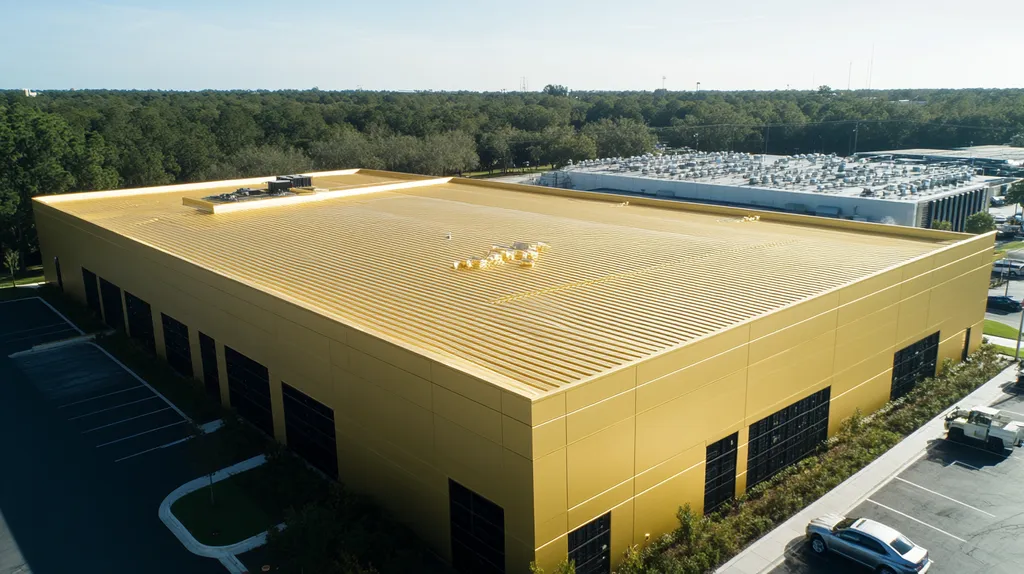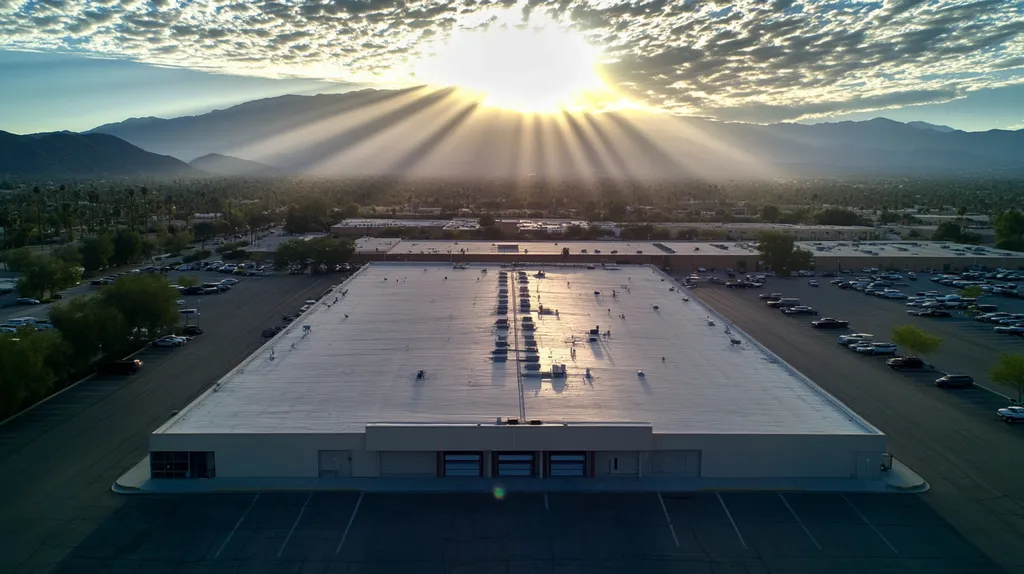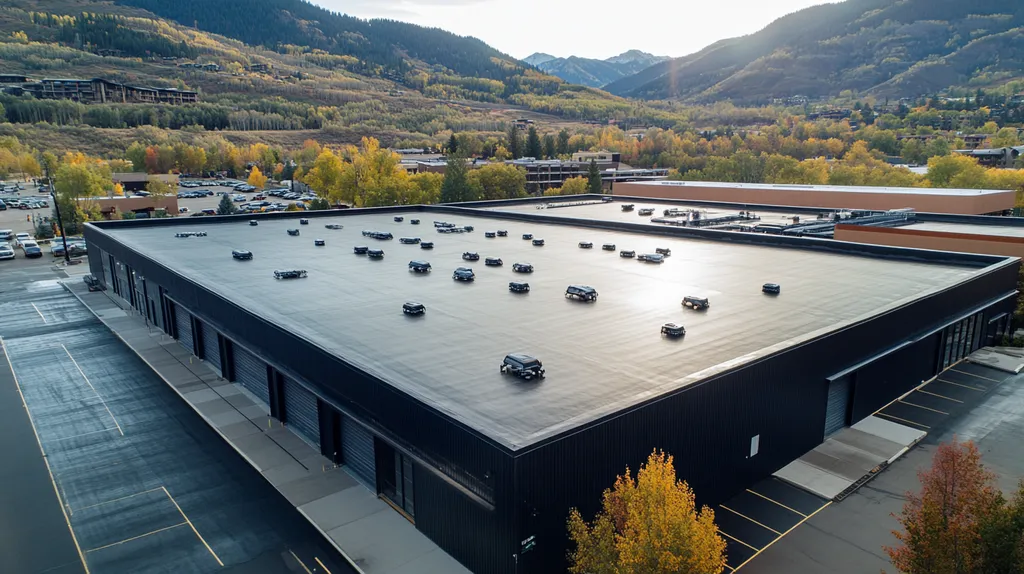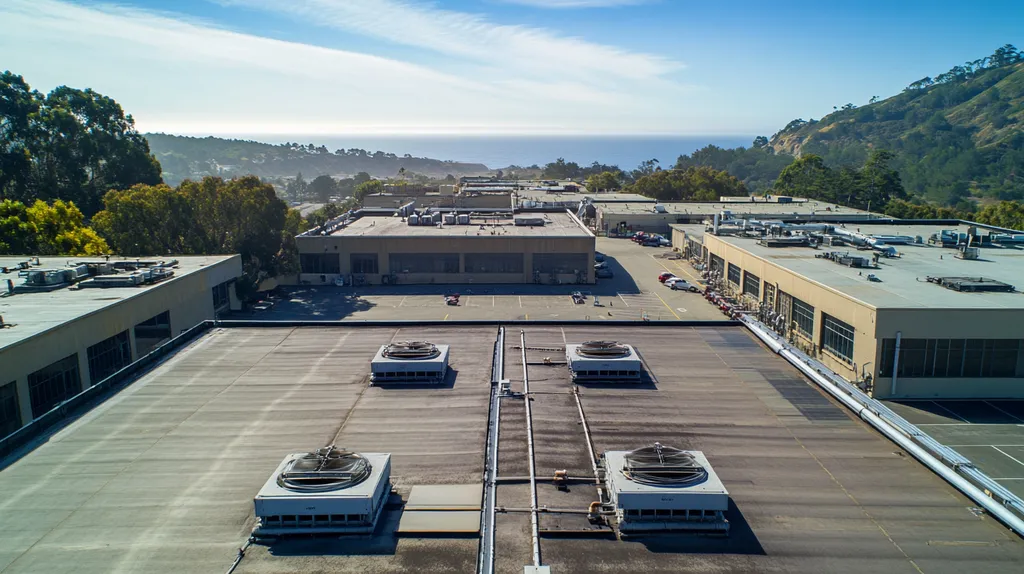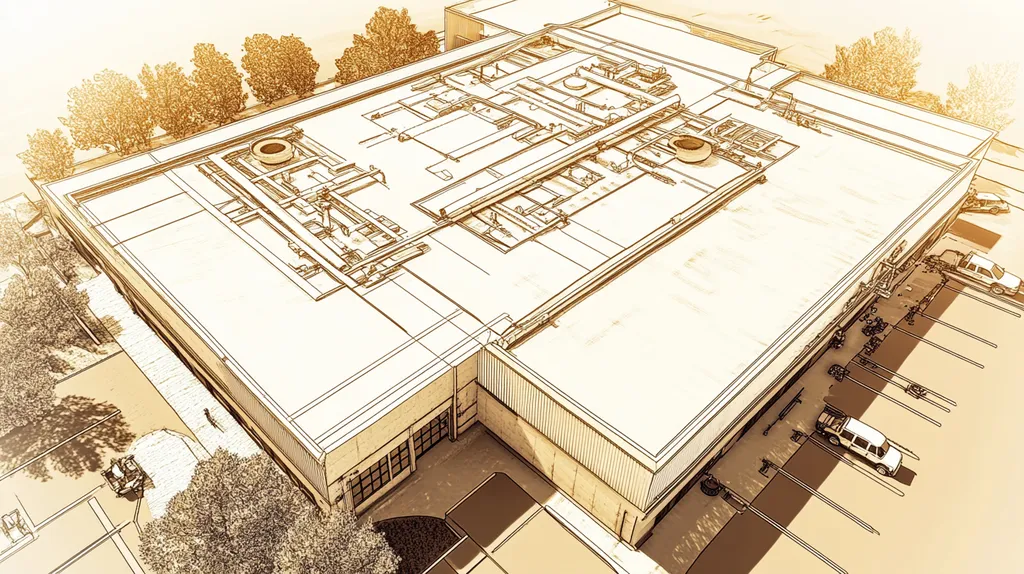Welcome to today’s Battle Royale featuring two roofing heavyweights: “TPO” in the east corner versus “EPDM” in the west!
Tonight’s showdown pits these contenders against each other across six punishing rounds designed to test every aspect of their performance for local building codes for commercial roofs.
At stake? Millions in potential costs, decades of building protection, and the critical performance demands of modern commercial and industrial facilities.
Our professional judging panel will evaluate each round on technical merit, real-world performance, and value delivery. After all six rounds, we’ll declare our ultimate champion.
Ladies and gentlemen, facility managers and building owners… it’s time to rumble!
ROUND 1: INITIAL COSTS & INSTALLATION
When selecting commercial roofing materials, property owners must navigate complex building code requirements while balancing cost considerations. The International Building Code (IBC) establishes minimum requirements for roof assemblies that directly impact material selection and installation methods. Understanding these requirements alongside cost implications is crucial for making code-compliant, cost-effective decisions.
Material Expenses
Building codes designate specific roofing requirements based on building size, occupancy, and location, directly affecting material choices. TPO membranes typically cost $3.50-5.50 per square foot and readily meet most commercial code requirements for fire resistance and wind uplift resistance.
EPDM materials range from $4.00-7.00 per square foot and must also conform to fire-resistance classification requirements based on construction type and building use group. Both systems must demonstrate compliance with location-specific wind load requirements as outlined in Chapter 15 of the IBC. (source: IBHS)
While both materials meet code requirements, TPO’s lower cost structure provides a clear advantage in this category, particularly for large-scale commercial applications.
Installation Complexity
TPO installation involves straightforward heat-welded seams and typically requires fewer specialized tools. The simplified process helps ensure consistent code compliance while reducing labor costs and potential installation errors.
EPDM installations demand more intricate adhesive applications and careful seam work. This complexity increases the risk of installation-related code violations, particularly around penetrations and edge details.
TPO’s streamlined installation process makes it easier to maintain consistent quality and code compliance, giving it an advantage in this category.
Project Timeline
Commercial roofing projects must balance speed with proper code compliance. TPO installations typically complete in 25-40% less time than comparable EPDM projects, allowing for faster inspections and occupancy approval.
EPDM installations require longer curing times for adhesives and more complex detailing work. Weather sensitivity and additional inspection points can further extend project timelines.
TPO’s faster installation timeline while maintaining code compliance gives it a clear advantage in meeting project schedules and minimizing business disruption.
ROUND 1 WINNER: TPO
ROUND 2: DURABILITY & LIFESPAN
Building code compliance directly impacts the long-term performance of commercial roofing systems. When roofing materials fail prematurely, businesses face not just repair costs but potential code violations, insurance issues, and liability concerns. Understanding how TPO and EPDM systems perform over time within code requirements is essential for making sound investment decisions.
Durability Against Weather Conditions
Commercial roofing systems must meet specific code requirements for weather resistance based on geographic location and building type. TPO’s heat-welded seams and reflective surface provide excellent resistance to UV degradation and wind uplift, meeting or exceeding most local code requirements.
EPDM’s flexible rubber composition allows it to maintain performance across extreme temperature variations. Its elasticity helps it comply with expansion and contraction requirements in building codes, particularly in regions with dramatic seasonal changes.
Both materials demonstrate strong weather resistance capabilities when properly installed to code specifications. However, TPO’s superior seam strength and reflective properties give it an “ADVANTAGE” in this category.
Lifespan Expectations
Building codes mandate minimum performance standards throughout a roof’s service life. TPO roofs typically maintain code compliance for 15-20 years, though newer formulations may extend this timeframe when properly maintained.
EPDM systems consistently demonstrate 25-30 year lifespans while maintaining code compliance. The material’s chemical stability and resistance to oxidation help it maintain structural integrity longer than most synthetic alternatives.
EPDM’s proven track record of long-term performance and code compliance gives it a clear “ADVANTAGE” in this category.
Maintenance Requirements
Local building codes require regular roof inspections and maintenance to ensure ongoing compliance. TPO’s welded seams and smooth surface simplify inspection processes and reduce maintenance complexity, making code compliance easier to verify and maintain.
EPDM systems often require more frequent inspections of seams and flashings to ensure continued code compliance. The material’s susceptibility to punctures and seam failures can necessitate more intensive maintenance protocols.
TPO’s lower maintenance burden and easier compliance verification give it an “ADVANTAGE” in this category.
ROUND 2 WINNER: TPO
ROUND 3: PERFORMANCE FACTORS
Commercial roofing performance directly impacts building code compliance, occupant safety, and long-term operating costs. When roofing systems fail to meet performance standards, property owners face regulatory penalties, increased insurance premiums, and potential liability. Understanding how TPO and EPDM perform under real-world conditions is essential for making code-compliant decisions that protect valuable assets.
Weather Resistance
Geographic location and climate conditions significantly influence roofing material selection. TPO’s heat-welded seams and reflective surface deliver superior resistance to UV exposure and high temperatures, particularly in southern regions.
EPDM demonstrates exceptional flexibility across temperature extremes, maintaining its integrity during freeze-thaw cycles. Its elastic properties make it particularly effective in northern climates where thermal cycling is severe.
Both materials demonstrate strong weather resistance when properly installed. However, TPO’s superior seam strength and reflective properties give it an “ADVANTAGE” in most climate zones.
Energy Efficiency
Modern building codes increasingly emphasize energy performance requirements. TPO’s highly reflective surface reduces cooling loads and helps buildings meet energy efficiency standards, particularly in cooling-dominated climates.
EPDM’s dark surface absorbs more solar radiation, which can increase cooling costs in warm regions. While this heat absorption can be beneficial in cold climates, it often conflicts with energy code requirements focused on reducing cooling loads.
TPO’s superior reflectivity and alignment with energy efficiency codes gives it a clear “ADVANTAGE” in this category.
Fire and Wind Resistance
Building codes mandate specific requirements for fire resistance and wind uplift based on construction type and building use. TPO membranes readily achieve Class A fire ratings and demonstrate excellent wind uplift resistance through their heat-welded seams.
EPDM systems provide comparable fire resistance ratings but may require additional reinforcement at seams to meet wind uplift requirements. The material’s flexibility can actually enhance performance during high-wind events when properly secured.
With both systems meeting core safety requirements similarly, this category results in a “TIE” between the materials.
ROUND 3 WINNER: TPO
ROUND 4: MAINTENANCE REQUIREMENTS
Commercial roofing maintenance directly impacts building code compliance, safety standards, and long-term facility operations. Proper maintenance protocols protect valuable assets while preventing costly violations and emergency repairs. Understanding the maintenance requirements for TPO and EPDM systems is crucial for making informed decisions that align with local building codes and protect property investments.
Inspection Requirements
Regular roof inspections are essential for maintaining code compliance and preventing system failures. A Building Permit is required for all commercial roof covering replacements, with specific inspection protocols that must be scheduled at least one business day in advance. (source: MNSPECT)
TPO roofing systems feature easily inspectable seams and surfaces, making compliance verification straightforward. The material’s white surface allows inspectors to quickly identify potential issues during routine examinations.
EPDM systems require more detailed inspections due to their dark color and adhesive-based seams. This increased complexity can make code compliance verification more challenging and time-consuming.
TPO’s simplified inspection process and easier compliance verification give it an “ADVANTAGE” in this category.
Repair Protocols
TPO repairs typically involve heat-welding new material directly to the existing membrane. This process creates strong, reliable repairs that maintain system integrity and code compliance.
EPDM repairs often require careful surface preparation and adhesive application. The complexity of these repairs increases the risk of future failures and potential code violations.
The straightforward nature of TPO repairs and their consistent reliability give TPO an “ADVANTAGE” in this category.
Preventive Maintenance
TPO’s smooth surface resists dirt accumulation and biological growth, reducing the frequency of required cleaning. The material’s heat-welded seams maintain their integrity with minimal preventive maintenance.
EPDM systems benefit from regular cleaning to prevent contamination and maintain proper drainage. The material’s adhesive-based seams require periodic inspection and preventive maintenance to ensure continued performance.
TPO’s reduced maintenance requirements and superior seam stability give it an “ADVANTAGE” in this category.
ROUND 4 WINNER: TPO
ROUND 5: SUSTAINABILITY CREDENTIALS
Modern building codes increasingly emphasize sustainable construction practices, with some jurisdictions mandating specific environmental performance metrics for commercial roofing systems. Property owners who fail to meet these requirements face costly retrofits, permit denials, and potential legal penalties. Understanding how roofing material choices impact sustainability compliance has become critical for protecting both environmental and financial interests.
Energy Performance Standards
Building codes now commonly specify minimum solar reflectance and thermal emittance values for commercial roofing materials. TPO membranes typically exceed these requirements with solar reflectance ratings above 0.70 and thermal emittance above 0.75, helping buildings achieve compliance with energy efficiency mandates.
EPDM’s dark surface absorbs more solar radiation, potentially conflicting with energy code requirements in cooling-dominated climates. While white-coated EPDM options exist, they generally don’t match TPO’s baseline performance in meeting reflectivity standards.
TPO’s superior energy performance characteristics give it a clear ADVANTAGE in meeting current and future code requirements.
Material Life Cycle Impact
Sustainable building codes increasingly address the full environmental impact of roofing materials. TPO membranes can be fully recycled at end-of-life, supporting circular economy initiatives and helping projects meet waste reduction requirements.
EPDM recycling options remain limited, with most materials ultimately reaching landfills. This limitation can impact compliance with green building codes that mandate specific recycling or waste diversion targets.
TPO’s recyclability and lower life cycle impact give it an ADVANTAGE in meeting sustainability requirements.
Chemical Content Compliance
Environmental regulations within building codes increasingly restrict certain chemical compounds in construction materials. TPO formulations generally comply with these restrictions without modification, simplifying the approval process.
EPDM manufacturing involves some chemicals that may face increasing scrutiny under evolving environmental regulations. While currently compliant, future code changes could impact material availability or installation requirements.
TPO’s forward-compatible chemical composition gives it an ADVANTAGE in meeting current and anticipated regulations.
ROUND 5 WINNER: TPO
ROUND 6: SPECIALIZED APPLICATIONS
Specialized commercial roofing applications present unique challenges that directly impact building code compliance, system performance, and long-term facility operations. When roofing systems fail to meet specialized requirements, property owners face expensive remediation, compliance violations, and potential business disruptions. Understanding how TPO and EPDM perform in demanding applications is crucial for making informed decisions that protect valuable assets.
Environmental Performance Requirements
The Florida Building Code has strengthened requirements for roof assemblies to improve resistance to wind and water infiltration damage. These changes include specific underlayment requirements and wind load calculations based on property location. (source: Florida Building Code)
TPO systems excel in meeting these enhanced requirements through their heat-welded seams and superior wind uplift resistance. The material’s chemical stability and reinforced membrane composition provide excellent protection against water infiltration.
EPDM systems may require additional reinforcement at seams and careful detailing to meet stringent wind uplift requirements. While the material provides good water resistance, its reliance on adhesive seams can create potential weak points in high-wind zones.
TPO’s superior performance in meeting enhanced environmental requirements gives it an ADVANTAGE in this category.
Chemical Exposure Resistance
Specialized applications often expose roofing materials to harsh chemicals, industrial emissions, or atmospheric pollutants. These exposures must be considered alongside standard code requirements to ensure long-term performance.
TPO membranes demonstrate excellent resistance to common industrial chemicals and pollutants. Their thermoplastic composition maintains integrity even when exposed to mild acids, bases, and organic compounds.
EPDM shows superior resistance to certain chemicals but can be vulnerable to petroleum-based products and some industrial solvents. This limitation can restrict its use in facilities where chemical exposure is likely.
TPO’s broader chemical resistance profile gives it an ADVANTAGE in this category.
High-Traffic Applications
Commercial roofs often serve as platforms for mechanical equipment access and routine maintenance activities. These high-traffic applications require materials that maintain code compliance while resisting physical damage.
TPO membranes can be manufactured with increased thickness and reinforcement to handle regular foot traffic. Their heat-welded seams maintain integrity even under frequent mechanical stress.
EPDM systems typically require additional protection layers in high-traffic areas. While durable, the material’s susceptibility to punctures and tears can lead to maintenance issues and potential code violations.
TPO’s superior traffic resistance and maintained compliance give it an ADVANTAGE in this category.
ROUND 6 WINNER: TPO
AND THE WINNER IS…
After six grueling rounds of technical evaluation, we have our verdict…
In a stunning display of technical dominance, TPO emerges as our undisputed champion, winning five rounds with one tie! This powerhouse performer demonstrated superior cost-effectiveness, streamlined installation, exceptional energy efficiency, and outstanding maintainability throughout the competition.
TPO’s victories in critical categories like initial costs, performance factors, and sustainability credentials showcase why it’s becoming the go-to choice for modern commercial roofing applications.
But don’t count EPDM out completely! This seasoned veteran still packs a mighty punch when it comes to extreme temperature variations and proven long-term durability. For facilities in northern climates or applications demanding ultimate flexibility, EPDM remains a formidable contender.
Important Notice: Every building presents unique challenges that can impact roofing system selection. Local climate conditions, building codes, and specific property characteristics all play crucial roles in determining the optimal solution. While this analysis provides general guidance, property owners should always consult qualified roofing professionals who can evaluate their specific situation and requirements.
Ladies and gentlemen, in the high-stakes arena of commercial roofing, remember: The true champion isn’t just the material with the most wins – it’s the one that best matches your building’s specific needs and challenges. Choose wisely, and may your roof reign supreme!
FREQUENTLY ASKED QUESTIONS
Q. What are the initial costs for a commercial roof?
A. Initial costs for commercial roofs differ between materials. TPO membranes typically cost between $3.50 and $5.50 per square foot, while EPDM ranges from $4.00 to $7.00 per square foot. It’s essential to consider local building codes influencing material choices when evaluating overall expenses.
Q. How long do commercial roofs last per building codes?
A. Lifespan expectations for commercial roofs vary based on standards. TPO roofs typically comply for about 15-20 years, while EPDM systems often last 25-30 years. Adhering to maintenance guidelines is crucial for longevity under local building codes.
Q. What performance factors affect commercial roof compliance?
A. Performance factors include weather resistance, energy efficiency, and fire ratings. Local building codes mandate compliance in these areas, impacting liability and insurance costs. It’s vital to choose materials that meet these performance criteria for ongoing compliance.
Q. How do maintenance requirements vary for commercial roofs?
A. Maintenance requirements differ based on material. TPO roofs generally require fewer inspections and repairs, making compliance verification easier. In contrast, EPDM systems mandate more frequent checks and can need intensive maintenance to avoid compliance issues.
Q. What are the sustainability credentials of commercial roof materials?
A. Sustainability credentials focus on energy performance and lifecycle impact. TPO membranes generally exceed energy efficiency standards, while EPDM may fall short in specific climates. Additionally, TPO is recyclable, while EPDM has limited recycling options.
Q. How do specialized applications impact commercial roofing choices?
A. Specialized applications often require heightened performance standards. TPO typically meets stringent wind and water damage requirements effectively, while EPDM may need additional preparations. Understanding these needs ensures compliance with local building codes for unique scenarios.
Q. What potential code violations should I be aware of for commercial roofs?
A. Potential code violations include non-compliance with fire ratings, wind resistance, and energy efficiency standards. Failure to adhere to local codes can result in project delays, financial penalties, and increased liability risks. Regular inspections and appropriate materials help mitigate these issues.

